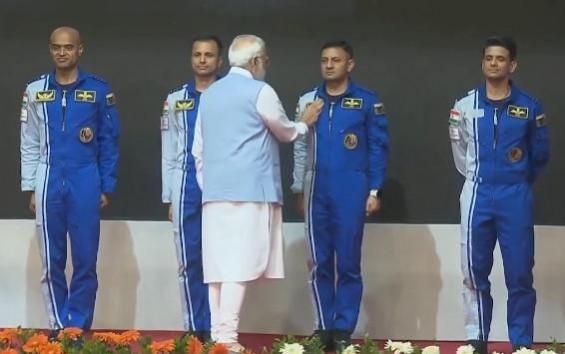
India's space exploration journey has reached a significant milestone with the announcement of the country's first human space flight mission, Gaganyaan. Prime Minister Narendra Modi revealed the names of the four astronauts chosen for this historic mission during his visit to the Indian Space Research Organisation's (ISRO) Vikram Sarabhai Space Station on Tuesday. The chosen astronauts, Group Captain Prasanth Balakrishnan Nair, Group Captain Ajit Krishnan, Group Captain Angad Pratap, and Wing Commander Shubhanshu Shukla, are currently undergoing rigorous training for the mission, which is slated for 2025.
The Prime Minister expressed his elation at the announcement, stating that these astronauts will bring new glory to the nation's space exploration programs. The Gaganyaan mission is a testament to India's growing prowess in space exploration. It follows the successful landing of Chandrayaan on the South Pole of the Moon last year, making India the only nation to achieve this feat.
The mission is part of ISRO's ambitious plans, which include setting up its own 'Bharatiya Antariksha Station' by 2035 and sending the first Indian to the Moon by 2040.
The Astronauts and Their Training
The four astronauts, all alumni of the National Defence Academy (NDA), have undergone comprehensive training in Russia and India to prepare for the maiden spaceflight. Group Captain Prasanth Balakrishnan Nair, a distinguished fighter pilot with an illustrious career in the Indian Air Force (IAF), is at the helm of this historic endeavor. Born in Thiruvazhiyad, Kerala, Group Captain Nair's journey into the skies began after his studies at the NDA. He has since accumulated approximately 3,000 hours of flying experience across a diverse fleet, including the formidable Su-30 MKI, MiG-21, and MiG-29, among others.
The astronauts' training curriculum has been designed by Wing Commander Rakesh Sharma (retired) and Air Commodore Ravish Malhotra (retired), both of whom underwent training for the Soviet Intercosmos Programme. The training includes theoretical courses, physical fitness training, simulator training, and flight suit training. As part of the Gaganyaan mission, India carried out a crucial test flight — Flight Test Vehicle Abort Mission-1 (or TV-D1) — in October last year to demonstrate whether the crew could safely escape the rocket in case it malfunctioned.
India's Space Ambitions
The Prime Minister expressed confidence that as India progresses to become the world's third-largest economy, the Gaganyaan mission will propel the nation's space sector to unprecedented heights. He also highlighted the significant contribution of female scientists in the field of space technology, stating, "India's Nari Shakti is playing a pivotal role in the space sector. Be it Chandrayaan or Gaganyaan, no such mission can be imagined without women scientists."

The announcement of the Gaganyaan mission has been met with widespread excitement and pride among the Indian public. Social media platforms have been flooded with congratulatory messages and well-wishes for the astronauts and the ISRO team. The mission is seen as a significant step towards establishing India's presence in global space exploration.
The Gaganyaan mission is reminiscent of the historic Apollo missions by NASA, which marked the first time humans set foot on the moon. Just as the Apollo missions ignited a sense of pride and achievement among Americans, the Gaganyaan mission is set to do the same for Indians. It is a testament to the country's scientific prowess and ambition, and a symbol of national pride.
In conclusion, the Gaganyaan mission is a significant milestone in India's space exploration journey. It is a testament to the country's scientific capabilities and ambition. The mission, along with ISRO's future plans, promises to propel India to the forefront of global space exploration. As the world watches, India is poised to make history with its first human space flight mission. This historic endeavor is not just a leap into space, but a giant stride for India as a nation, marking its place in the annals of space exploration.
Key highlights
- India's first human space flight mission, Gaganyaan, was announced with four astronauts selected for the 2025 mission.
- The astronauts, all National Defence Academy alumni, are undergoing comprehensive training in Russia and India.
- The Gaganyaan mission is part of ISRO's ambitious plans, including setting up its own 'Bharatiya Antariksha Station' by 2035 and sending the first Indian to the Moon by 2040.
- The mission has been met with widespread excitement and pride, marking a significant milestone in India's space exploration journey.








